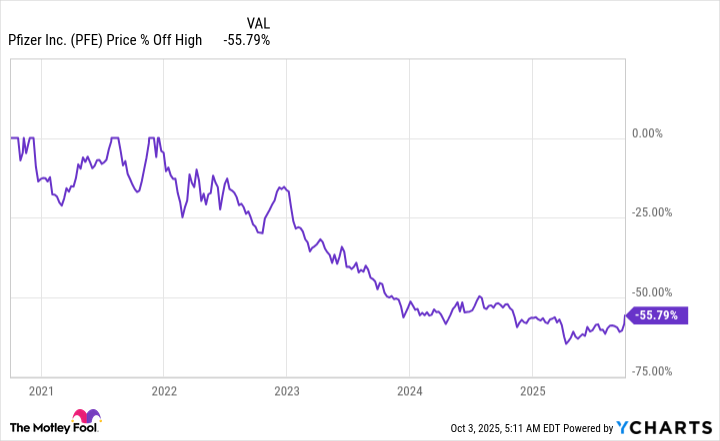Pfizer’s stock price is down materially from its 2021 highs, but it is also up notably from its April 2025 lows.
Pfizer (PFE -0.34%) has a huge 6.3% dividend yield. That’s actually a lot lower than it was not too long ago, thanks to a large stock advance in recent days based on news. But Pfizer’s price rebound actually started in April. Is it time to jump in before more on Wall Street start buying Pfizer’s depressed stock?

Image source: Getty Images.
What does Pfizer do?
Pfizer is a pharmaceutical company. This is a highly complex business that involves huge costs. A company needs to find potential new drug candidates, which requires a material commitment to research staff and facilities. Promising drugs then need to be researched and developed. Then they need to go through the approval process. And finally, assuming the drugs are actually useful and safe, they need to be marketed.
There are massive costs all along the way in what is a very long process of bringing a drug to market. As such, drug makers are granted a temporary period in which they have the exclusive right to sell a newly developed drug. That can lead to huge profits, at least for a period of time. When a drug patent runs out, competitors can make generic versions of the drug, which usually leads to the revenue from the original drug falling drastically. That’s known as a patent cliff.
Drug companies are always working to develop new drugs to offset the income statement hit when patent cliffs come up. That’s the big-picture cycle that Pfizer is always in the middle of. And it has done a very good job of managing to survive and thrive over time. But new drugs and patent cliffs don’t always line up quite as well as hoped, so there can be material short-term turbulence in earnings.
What’s up with Pfizer’s big price drop?
Pfizer’s stock price is currently down over 50% from the peaks it hit in late 2021. That high water mark was a bit of an anomaly, as it coincided with the coronavirus pandemic. Wall Street extrapolated the vaccine opportunity from COVID-19 way too far into the future. When the world learned to live with the illness, Pfizer’s stock plunged.
On top of that, Pfizer is currently facing down a patent cliff, with drugs for oncology (Ibrance) and cardiovascular health (Eliquis and Vyndaqel) set to lose patent protections in 2027 and 2028. This is a notable issue and it won’t be simple to solve. In fact, after the company’s own weight loss drug flamed out.
However, Pfizer has just inked an acquisition to gain access to a new weight loss drug opportunity. The deal to buy Metsera (MTSR 0.19%) is expensive and fairly complex, involving an earnout provision. The upfront cost is $47.50 per Metsera share (roughly $4.9 billion), with three earnouts that could add $22.50 per share to the cost. That said, this deal quickly solves a problem for Pfizer.
Pfizer has also made quick work of dealing with increasing regulatory pressure. It was the first company to come to an agreement with the U.S. government around drug pricing. The “specific terms of the agreement remain confidential,” but Pfizer has agreed to make material capital investments in U.S.-based assets in an effort to avoid tariffs.
Both of these moves appear to have resulted in Wall Street taking a more positive view of Pfizer’s future. The tariff deal, specifically, led to a huge one-day gain in Pfizer’s stock. That said, there is still a lot of work to do before Pfizer’s business fortunes are on the mend. But the situation does appear to be brightening.
Has enough changed to make Pfizer a buy?
Pfizer’s payout ratio is quite high, hovering around 90%. And the board of directors has made the call to cut the dividend in the past, specifically in 2009 when Pfizer bought Wyeth. That cut and the lofty payout ratio make Pfizer a potentially risky choice for conservative income investors looking a reliable dividend, even though the stock’s yield is attractively high.
That said, as a turnaround investment, Pfizer looks a lot more attractive. As the drug company has done before, it is taking the steps necessary to survive and thrive over the long term. In fact, the stock has risen from a 52-week low around $22 to a recent price of roughly $27, which is a 20% increase.
Clearly, Wall Street is starting to see the silver lining in Pfizer’s clouds. And if the dividend survives the current headwinds, all the better. Just be careful if you go in counting on that dividend to survive.

